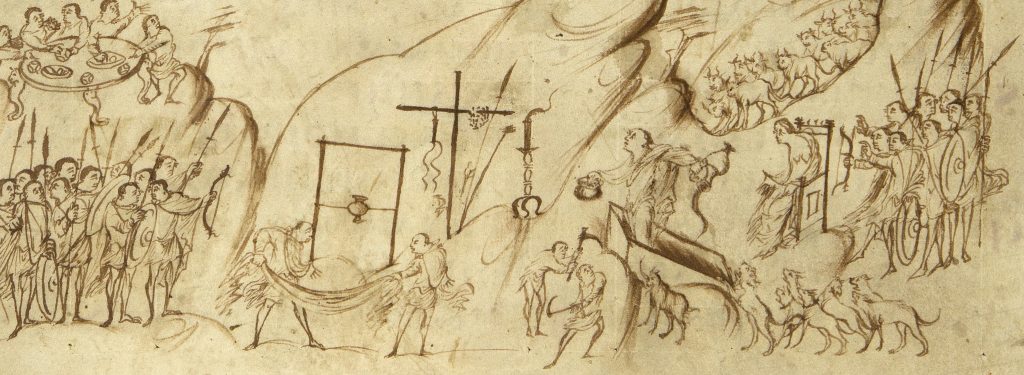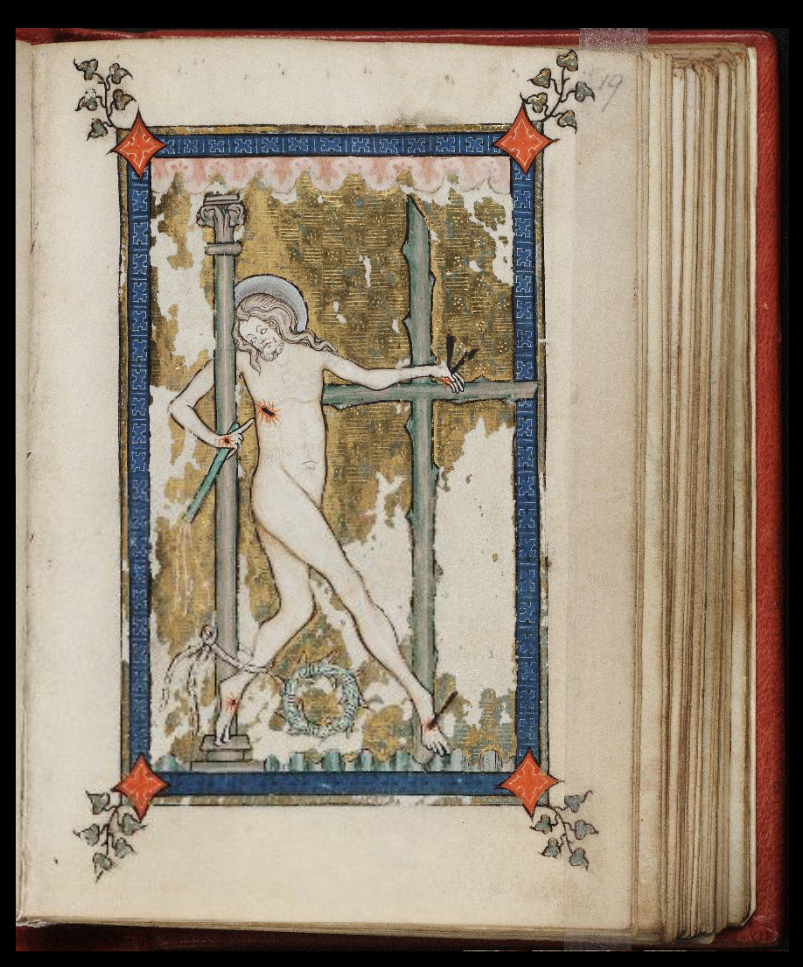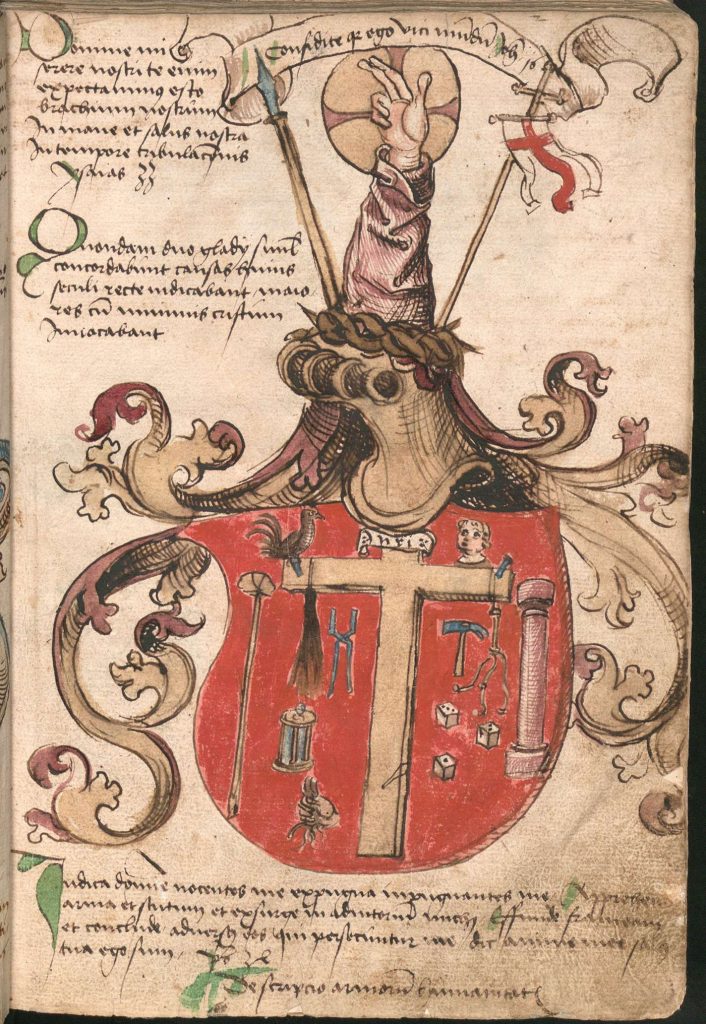The Art of Holy Week

Early in the ninth century, a team of artisans in what is now northeastern France produced a book of the Psalms. Known now as the Utrecht Psalter, the book presents every psalm accompanied by lively, almost doodle-like pen illustrations. Because of the large format of the book, some speculate that it was intended to serve young monks in the task of memorizing the psalms. The idea is that the illustrations provided prompts to aid one’s memory of the text. As seen above, among the drawings that go with Psalm 21 (“My God, my God why have you forsaken me?” – Identified as Psalm 22 in most English language Bibles) is an image of Jesus’ cross along with the crown of thorns, a whip, a lance and a hyssop branch with a sponge – all objects associated with Jesus Christ’s suffering and death.
This collection of objects would become a repeating image in medieval Christian art. Artists provided images of the cross along with the crown of thorns, a whip, sponge, lance, nails and the veil of Veronica, said to preserve the first image of Christ’s face. Some of the other objects that frequently appear are dice, a crowing rooster, a hammer and pliers, and pieces of silver. These are randomly arranged without apparent concern for their ordered place in the story or their relative size (the dice are frequently as big as the rooster). While each of the objects is easily identifiable, their collective meaning and purpose shifts subtly but meaningfully through the centuries, providing us with compelling ideas for Holy Week.
Known collectively as the Arma Christi (Weapons of Christ) use of these collected images increased in frequency through the 13th century as Western Christianity became more and more captivated by the idea and promise of relics, physical objects associated with the life of Jesus and the key figures of the New Testament and early church that were thought to be repositories of holy power and blessing. King Louis IX of France claimed to possess the actual crown of thorns used in Jesus’ crucifixion along with other relics of Christ’s passion, having purchased them from the Emperor of Constantinople, Baldwin II. One theory is that the drawings and sculptures of the Arma Christi were regarded primarily as images of these relics rather than merely illustrations of historical objects. As such the drawings could convey the same spiritual blessings – forgiveness of sins and admission into heaven upon death – as the actual relics did. The artwork made the relics more accessible.

Jesus displaying his wounded side. Notice that both the pillar to which he was tied while whipped and the cross of his crucifixion are simultaneously present.
Rothschild Canticles. General Collection, Beinecke Rare Book and Manuscript Library, Yale University. and Shailor, B. Catalogue of Medieval and Renaissance Manuscripts in the Beinecke Rare Book and Manuscript Library, MS 404.
By the 14th century in Northern Europe, the Arma Christi are appearing in prayer books along with prayers intended to help the individual Christian become more connected emotionally to the sufferings of Christ. The idea is that as one connects emotionally one might more fully gain access to the benefits that Christ’s sufferings bring to believers. The drawings are less about access to remote objects and more about a direct spiritual connection to Jesus. They are becoming more like illustrations than symbols.

The “Weapons of Christ” are visible both on the shield and above it.
Attributed coat of arms of Jesus (Arma Christi) in late 15th-century Wernigerode/Schaffhausen Armorial, Bavarian State Library
In the late fifteenth century, the Arma Christi were presented as a coat of arms for Jesus in the Wernigerode Armorial, a book which collects images of the heraldry, or coats of arms, of a number of royal houses across Europe. The book functions as a sort of royal inventory, identifying each house by what we might regard as an early logo made up of symbols intended to project power and authority. It’s in this context that I think the meaning of the Arma Christi makes another interesting and very helpful shift. In the context of this collected display of human power, the Arma Christi are presented as “weapons of Christ.” However, if we stop to think about it, all of the drawings are of weapons that are used against Christ. They are the tools and objects associated with those who betrayed and executed Jesus. Yet, the heraldry tradition identifies these as weapons that belong to Christ and are to be regarded as the evidence of his power and authority.
Jesus turns the weapons used against him into the very tools he employs to obtain his victory.
This great reversal lies behind the hymn that Paul quotes in his letter to the Philippians, “[Jesus] humbled himself and became obedient to the point of death – even death on a cross. Therefore God also highly exalted him and gave him the name that is above every name…”
It is the reason we call it “Good Friday.”
Pr. Jim
March 31, 2021
Rev. James A. Wetzstein serves as University Pastor at Valparaiso University and takes turns writing weekly devotions.
- Archives of Devotional Writings from our Pastoral Staff
- “HELP!”
- “Some Lent!”
- (Your vocation here) of people
- A call to courage for 2021
- A charming tale for over-achievers
- A Lesson On Beans … and Being
- A New Place
- A Point of Privilege
- A season of anticipation
- A Time of Dust
- Acquiring a peaceful spirit
- Advent = Hope
- All will be well
- Anastasis: the Greatest Story of God’s Saving Power
- Another kind of darkness
- Are we willing to cross the road for one another?
- As if we needed a reminder
- Beacons of hope
- Better Together
- Blessings As You Go
- Borderlands
- Can we learn to be happy?
- Carrying the COVID Cross
- Come and See
- Did Jesus really suffer?
- Doing without in a life of plenty
- Don’t miss this moment
- Exiles with Vision
- Fear not!
- Fear of the Lord
- Feeling at Home
- Finding Purpose in the Journey
- Finding Words for Times Like These
- Forgiving others – and ourselves
- Getting ahead with Jesus
- Getting down on Jesus’ level
- Getting through this together
- God is not overwhelmed
- Good Friday
- Grief & Graduation
- Have yourself a merry little Christmas — somehow
- Holy Week and Taking Out the Trash
- Holy Week: The aid station late in the semester
- Hopes & Dreams vs Life in the Wilderness
- How do you keep from giving up hope?
- How glad we’ll be if it’s so
- I almost slipped
- Imagining Eternity
- In a time of uncertainty, these things are certain
- In everything, grateful
- In praise of plans B … C … D …
- In the midst of grief, God will bring life
- Is there such a thing as being too forgiving?
- It’s a Three Day Weekend!
- It’s In the Bag
- It’s What’s Happening
- Jesus among us
- Killing off our future selves
- Knowing a Good Thing When We See It
- Lessons in fire building
- Let there be light!
- Let us work for real wellness in our communities
- Life Is a Highway
- Lilies and leaves and whatever else is beautiful
- Living in the Present
- Naming our demons
- O Lord, you know I hate buttermilk
- Of Fear and Failure
- On Christian Unity: When we’re not one big happy church
- On the Bucket List
- On the day after the night before
- Overwhelmed
- Persistent and Extravagant
- Pray and Let God Worry
- Praying for Reconciliation
- Preparing for the world to be turned rightside up
- Recovering from an Epic Fail
- Reformation calls for examination
- Remembering among the forgetful
- Rest
- Rest is Holy
- Right where we are
- Seeing beauty in brokenness
- Signs of Love
- Starting Small
- Still in the storm
- Surprisingly Simple: Breathe!
- Taking a Break from the Relentless
- Talking ourselves into it
- Thankfulness leads to joyfulness
- The Art of Holy Week
- The Funny Business of Forgiveness
- The Greatest of These is Love
- The Magi: Exemplars of Faith and Learning
- The Power of Small Conversations
- The Trouble with Mammon
- The Power of Taking a Sabbath
- The Spiritual Gift of Hindsight
- This can’t be done alone
- To be known
- Too.Much.
- You might be a Lutheran if…
- You will be in our prayers this summer of 2020
- Ventures of which we cannot see the ending
- WWJD? We already know
- Walking in the Light of Jesus’ Resurrection
- We had hoped
- We’re on a mission from God
- What do you do with your anger?
- What good is a shepherd?
- What is your base reality?
- What to do after you find your voice
- What to do on the day after
- What we know and what we don’t know
- When bad things happen
- When God uses something terrible for good
- When heaven & earth click
- When joy and sadness live together
- When stress overwhelms
- When the promise of resurrection is hard to believe
- When you offer up your broken cup
- When we are moved
- Where God will be found
- Where is the good shepherd carrying you?
- Wilderness Journeys
- Won’t you be my neighbor?
- Year-end time management: Keeping the main thing the main thing
- Your Valpo roots will help you grow into your future
